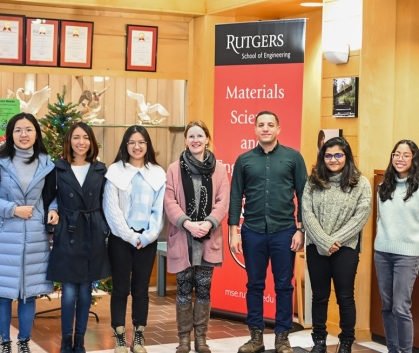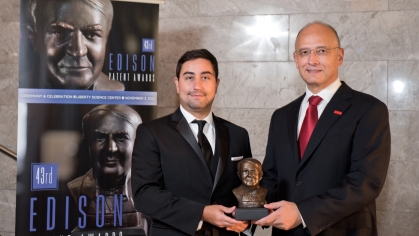MSE Professor is Shedding New Light on OLED Displays with NSF and Rutgers Support

Deirdre O’Carroll, an associate professor and graduate program director in the School of Engineering Department of Materials Science and Engineering recently received a $250,000 National Science Foundation (NSF) Partnerships for Innovation-Technology Translation (PFI-TT) award to improve the energy efficiency and durability of displays used in portable electronic devices. She has also received Rutgers Innovation Ventures TechAdvance funding for her related project, “Stable and Efficient Blue Organic Light-Emitting Diodes.”
While O’Carroll is a Rutgers collaborator in a regional, NSF-funded consortium to advance research and workforce development in photonics, a growing field that employs light in everything from fiber optics to precision manufacturing, her new $250,000 NSF-PFI-supported project also has a photonics theme.
During the course of the project, O’Carroll will be training two graduate students in advanced photonics materials science and research, as well as involving other students in her O’Carroll Research Group lab, and summer Research Experiences for Undergraduates (REU) students in supporting roles.
O’Carroll recalls that nearly a decade ago, she had an idea that plasmonic metasurface electrodes could be used to make photons emit more quickly from phosphorescent organic light-emitting diode (OLED) light-emitting materials. This in turn could extend the operational lifetime and reduce the cost and power usage of the organic light-emitting diode (OLED) displays used in smart phones and watches, tablets, and AR/VR headsets.
“The PFI-TT award for my project means we get to test the commercial potential of our metasurface electrode technology and finally start to see the idea’s potential use,” she says. “I’m excited to see the full potential of our technology in commercially relevant devices.”
Developing Prototype Devices
Using advanced photonic materials that can work with current OLED manufacturing processes could help solve the ongoing problem of the low stability and efficiency of current OLED displays by significantly increasing the photostability of high-efficiency blue phosphorescent OLED. Blue OLEDs suffer substantially more degradation during operation and their efficiency is about half that of red and green OLEDs. OLED manufacturers are continually seeking solutions to the blue OLED problem so that future generations of OLED displays can be brighter, more energy-efficient, higher resolution, and longer lasting compared to current generations.
Ultimately, her NSF PFI-TT project will develop prototype devices using the new technology that she describes as being relevant to the “top-emitting OLED device architecture used in
OLED displays for portable electronics.” Additionally, the project will develop novel fabrication methods for metasurfaces that are compatible with existing OLED manufacturing.
By delivering greater brightness and longer lifetime, portable OLED display manufacturers currently adopting top-emitting OLED device architectures for cell phones, smart watches and microdisplays, could likely adopt her technology within the next few years.
O’Carroll adds, “We have two issued patents relating to this technology and we hope to find interest among display manufacturers for our technology.”
A Complimentary Project
Commercial blue OLEDs consume more than twice as much electricity as red and green OLEDs. As smart phone, and other portable device manufacturers continue their search for solutions to the blue OLED problem, the project supported by Rutgers Innovation Ventures TechAdvance will help to develop the next generation of OLED TV display and lighting technologies.
“This internal funding supports additional work on bottom-emitting OLEDs and alternative methods to incorporate plasmonic nanomaterials into OLEDs,” says O’Carroll, whose project team includes materials science doctoral students Sneha Sreekumar, and Haydee Pacheco. “The scope of the work is different, but this internal project and my NSF PFI-TT project are complimentary in that they each address different needs within the OLED display industry.”


